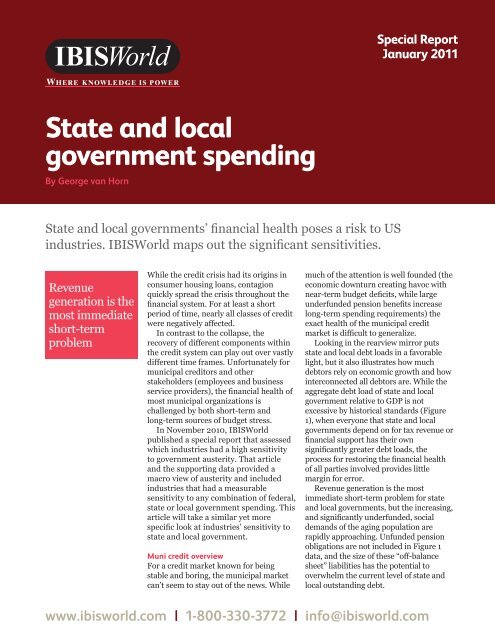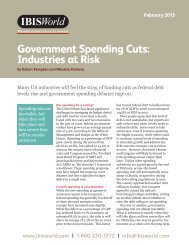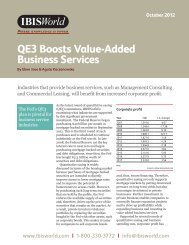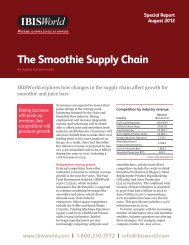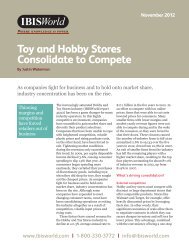State and local government spending - IBISWorld
State and local government spending - IBISWorld
State and local government spending - IBISWorld
Create successful ePaper yourself
Turn your PDF publications into a flip-book with our unique Google optimized e-Paper software.
WWW.IBISWORLD.COM Special Report Month 2010 1<br />
Municipal debt<br />
Special Report<br />
January 2011<br />
<strong>State</strong> <strong>and</strong> <strong>local</strong><br />
<strong>government</strong> <strong>spending</strong><br />
By George van Horn<br />
<strong>State</strong> <strong>and</strong> <strong>local</strong> <strong>government</strong>s’ financial health poses a risk to US<br />
industries. <strong>IBISWorld</strong> maps out the significant sensitivities.<br />
Revenue<br />
generation is the<br />
most immediate<br />
short-term<br />
problem<br />
While the credit crisis had its origins in<br />
consumer housing loans, contagion<br />
quickly spread the crisis throughout the<br />
financial system. For at least a short<br />
period of time, nearly all classes of credit<br />
were negatively affected.<br />
In contrast to the collapse, the<br />
recovery of different components within<br />
the credit system can play out over vastly<br />
different time frames. Unfortunately for<br />
municipal creditors <strong>and</strong> other<br />
stakeholders (employees <strong>and</strong> business<br />
service providers), the financial health of<br />
most municipal organizations is<br />
challenged by both short-term <strong>and</strong><br />
long-term sources of budget stress.<br />
In November 2010, <strong>IBISWorld</strong><br />
published a special report that assessed<br />
which industries had a high sensitivity<br />
to <strong>government</strong> austerity. That article<br />
<strong>and</strong> the supporting data provided a<br />
macro view of austerity <strong>and</strong> included<br />
industries that had a measurable<br />
sensitivity to any combination of federal,<br />
state or <strong>local</strong> <strong>government</strong> <strong>spending</strong>. This<br />
article will take a similar yet more<br />
specific look at industries’ sensitivity to<br />
state <strong>and</strong> <strong>local</strong> <strong>government</strong>.<br />
Muni credit overview<br />
For a credit market known for being<br />
stable <strong>and</strong> boring, the municipal market<br />
can’t seem to stay out of the news. While<br />
much of the attention is well founded (the<br />
economic downturn creating havoc with<br />
near-term budget deficits, while large<br />
underfunded pension benefits increase<br />
long-term <strong>spending</strong> requirements) the<br />
exact health of the municipal credit<br />
market is difficult to generalize.<br />
Looking in the rearview mirror puts<br />
state <strong>and</strong> <strong>local</strong> debt loads in a favorable<br />
light, but it also illustrates how much<br />
debtors rely on economic growth <strong>and</strong> how<br />
interconnected all debtors are. While the<br />
aggregate debt load of state <strong>and</strong> <strong>local</strong><br />
<strong>government</strong> relative to GDP is not<br />
excessive by historical st<strong>and</strong>ards (Figure<br />
1), when everyone that state <strong>and</strong> <strong>local</strong><br />
<strong>government</strong>s depend on for tax revenue or<br />
financial support has their own<br />
significantly greater debt loads, the<br />
process for restoring the financial health<br />
of all parties involved provides little<br />
margin for error.<br />
Revenue generation is the most<br />
immediate short-term problem for state<br />
<strong>and</strong> <strong>local</strong> <strong>government</strong>s, but the increasing,<br />
<strong>and</strong> significantly underfunded, social<br />
dem<strong>and</strong>s of the aging population are<br />
rapidly approaching. Unfunded pension<br />
obligations are not included in Figure 1<br />
data, <strong>and</strong> the size of these “off-balance<br />
sheet” liabilities has the potential to<br />
overwhelm the current level of state <strong>and</strong><br />
<strong>local</strong> outst<strong>and</strong>ing debt.<br />
www.ibisworld.com | 1-800-330-3772 | info@ibisworld.com
WWW.IBISWORLD.COM Special Report Month 2010 2<br />
Municipal debt<br />
About <strong>IBISWorld</strong> Inc.<br />
Recognized as the nation’s<br />
most trusted independent<br />
source of industry <strong>and</strong><br />
market research, <strong>IBISWorld</strong><br />
offers a comprehensive<br />
database of unique<br />
information <strong>and</strong> analysis on<br />
every US industry. With an<br />
extensive online portfolio,<br />
valued for its depth <strong>and</strong><br />
scope, the company equips<br />
clients with the insight<br />
necessary to make better<br />
business decisions.<br />
Headquartered in<br />
Los Angeles, <strong>IBISWorld</strong><br />
serves a range of business,<br />
professional service <strong>and</strong><br />
<strong>government</strong> organizations<br />
through more than<br />
10 locations worldwide.<br />
For more information, visit<br />
www.ibisworld.com or call<br />
1-800-330-3772.<br />
Contact:<br />
Savannah Haspel<br />
VP, Public Relations<br />
<strong>IBISWorld</strong><br />
Phone: 1-310-866-5044<br />
savannahh@ibisworld.com<br />
www.ibisworld.com<br />
FIGURE 1<br />
% change<br />
Debt levels as a percentage of GDP<br />
250<br />
200<br />
150<br />
100<br />
50<br />
0<br />
Year 1976 1979 1982 1985 1988 1991<br />
Federal Reserve Board data pegs 2009<br />
state <strong>and</strong> <strong>local</strong> <strong>government</strong> debt<br />
outst<strong>and</strong>ing at $2.4 trillion; however,<br />
Northwestern University economists<br />
recently pegged the size of underfunded<br />
pension liabilities at nearly $3.6 trillion<br />
($3.0 trillion of which relates to state<br />
pensions <strong>and</strong> $574.0 billion in city <strong>and</strong><br />
county liabilities).<br />
While many of the financial obligations<br />
described previously are long term in<br />
nature, recession-induced state <strong>and</strong> <strong>local</strong><br />
budget deficits leave few options to avoid<br />
immediate austerity measures. While the<br />
majority of states have implemented<br />
budget cuts or tax increases since the<br />
beginning of the recession, states are<br />
widely expected to remain in fiscal<br />
deficits through their 2012 fiscal year.<br />
Industry conditions <strong>and</strong> impacts<br />
As noted in the November 2010<br />
Government Austerity report, within<br />
<strong>IBISWorld</strong>’s database of more than 700<br />
US industries, about 176 have a<br />
measurable sensitivity to <strong>government</strong><br />
<strong>spending</strong>. The largest financial<br />
exposures to <strong>government</strong> <strong>spending</strong> are<br />
dominated by those sectors where both<br />
federal <strong>and</strong> state <strong>and</strong> <strong>local</strong> sensitivities<br />
are present: education, construction <strong>and</strong><br />
1994<br />
1997 2000 2003 2006 2009<br />
Household debt/GDP Business debt/GDP <strong>State</strong> <strong>and</strong> <strong>local</strong> debt/GDP Federal debt/GDP<br />
SOURCE: FEDERAL RESERVE BOARD<br />
medical. The military sector is unique<br />
because of its concentrated reliance on<br />
federal <strong>spending</strong>.<br />
Construction<br />
As summarized in Figure 2, the<br />
construction industry’s sensitivity is<br />
dominated by varied forms of<br />
infrastructure activity. It is even more<br />
noteworthy that the combined sensitivity<br />
to <strong>government</strong> <strong>spending</strong> exceeds 40% for<br />
the majority of industries; furthermore,<br />
for nearly all industries, state <strong>and</strong> <strong>local</strong><br />
sensitivities are far greater than those for<br />
federal <strong>spending</strong>.<br />
Medical<br />
There are 16 medical facilities <strong>and</strong><br />
practitioner industries that have<br />
sensitivity weights of 20 or higher based<br />
on federal Medicare <strong>and</strong> Medicaid<br />
funding. While nearly all medicalrelated<br />
industries have some sensitivity<br />
to public expenditure, these industries<br />
have increasingly relied on federal<br />
expenditure relative to state <strong>and</strong> <strong>local</strong><br />
funding during the past 20 years.<br />
Further, as an entitlement program,<br />
total Medicare <strong>and</strong> Medicaid <strong>spending</strong> is<br />
influenced by enacted legislation, not<br />
the annual budgeting process.
WWW.IBISWORLD.COM Special Report Month 2010 3<br />
Municipal debt<br />
FIGURE 2<br />
Construction industry sensitivity weights<br />
Water well<br />
Transmission line<br />
Roadway services<br />
Roadway maintenance<br />
Roadway construction<br />
Municipal building<br />
Heavy infrastructure<br />
Pipeline<br />
Bridge <strong>and</strong> tunnel<br />
0% 20% 40% 60% 80% 100%<br />
<strong>State</strong> <strong>and</strong> <strong>local</strong> Federal<br />
SOURCE: IBISWORLD<br />
Education<br />
University <strong>and</strong> college education <strong>and</strong><br />
primary <strong>and</strong> secondary (public) schools<br />
dominate the Education sector’s reliance<br />
on <strong>government</strong> funding (<strong>IBISWorld</strong><br />
sensitivity weightings of 30.0% <strong>and</strong><br />
40.0%, respectively). Of the estimated<br />
$1.1 trillion that was spent nationwide on<br />
education at all levels for the 2009-to-<br />
2010 school year, the vast majority came<br />
from state, <strong>local</strong>, <strong>and</strong> private sources. At<br />
the elementary <strong>and</strong> secondary level, the<br />
Department of Education estimates that<br />
about 89.5 percent of school funding<br />
comes from non-federal sources.<br />
Other sectors sensitive to<br />
state <strong>and</strong> <strong>local</strong> <strong>spending</strong><br />
The privately owned Correctional<br />
Facilities industry has the largest<br />
dependence on state <strong>and</strong> <strong>local</strong><br />
<strong>government</strong> clients (74.0% sensitivity),<br />
which is more than any industry outside<br />
of construction. While the dem<strong>and</strong> for<br />
correctional facilities in total (private <strong>and</strong><br />
public) will continue to grow, total direct<br />
expenditures on correctional services by<br />
<strong>government</strong>s will exp<strong>and</strong> at a more<br />
constrained rate. Private operators will<br />
face the same challenges as their public<br />
counterparts in constraining or lowering<br />
the cost of operating facilities.<br />
Environmental industries<br />
Municipal <strong>government</strong>s that do not own<br />
or operate their own l<strong>and</strong>fill or disposal<br />
facilities require the services of a private<br />
operator. Over time, <strong>local</strong> <strong>government</strong>s<br />
have been privatizing their waste<br />
collection services <strong>and</strong> their waste<br />
disposal sites. Local <strong>government</strong>s are<br />
increasingly looking at methods other<br />
than l<strong>and</strong>fill for waste disposal. Since the<br />
construction <strong>and</strong> operation of waste-toenergy<br />
plants is complex <strong>and</strong> capital<br />
intensive, <strong>local</strong> <strong>government</strong>s will likely<br />
outsource waste disposal to private<br />
industry operators.<br />
While trends in outsourcing of public<br />
operations may support various waste<br />
management industries, it is also highly<br />
likely that smaller municipalities will join<br />
forces in contracting services to improve<br />
their negotiating power; only the largest<br />
operators will survive. These contracting<br />
conditions will also affect many other<br />
industries that are sensitive to state <strong>and</strong><br />
<strong>local</strong> <strong>government</strong> <strong>spending</strong>.<br />
Financial<br />
<strong>State</strong> <strong>and</strong> <strong>local</strong> <strong>government</strong>s remain a<br />
significant force in the Retirement <strong>and</strong><br />
Pension Plans industry, in terms of the<br />
assets involved, <strong>and</strong> more importantly,<br />
because of their continued reliance on
WWW.IBISWORLD.COM Special Report Month 2010 4<br />
Municipal debt<br />
FIGURE 3<br />
National health expenditure<br />
2500<br />
2000<br />
$ billions<br />
1500<br />
1000<br />
500<br />
0<br />
Year 1960 1980 1993 1998 2000 2002 2004 2006 2008<br />
Private Federal <strong>State</strong> <strong>and</strong> <strong>local</strong><br />
SOURCE: CENTERS FOR MEDICARE AND MEDICAID SERVICES<br />
defined benefit plans. The private sector<br />
has moved toward defined contribution<br />
plans (i.e. 401[k] plans), but sponsors of<br />
defined benefit plans remain saddled<br />
with higher cost plans that are exposed to<br />
the financial risks associated with<br />
investment returns <strong>and</strong> the cost of future<br />
benefits.<br />
While municipal <strong>government</strong> pension<br />
benefits will likely be curtailed in the<br />
future, any significant progress in<br />
increased pension funding (reducing<br />
underfunded obligations) will benefit a<br />
h<strong>and</strong>ful of financial industries.<br />
Retirement <strong>and</strong> pension assets will grow<br />
along with the services provided to<br />
manage these assets (i.e. portfolio<br />
management or custody, asset <strong>and</strong><br />
securities services).<br />
Other<br />
The cloudy outlook for municipal financial<br />
conditions threatens a longer list of<br />
smaller municipal contractors, from<br />
surveying <strong>and</strong> mapping services to<br />
l<strong>and</strong>scaping, gun <strong>and</strong> ammo<br />
manufacturing, <strong>and</strong> even computer repair.<br />
One sub-sector that has a relatively<br />
high concentration of <strong>government</strong><br />
<strong>spending</strong> sensitivity is the Independent<br />
Performers <strong>and</strong> Creative Artists industry.<br />
While small in scale, the sensitivity to<br />
<strong>government</strong> <strong>spending</strong> for performing arts<br />
<strong>and</strong> independent performers st<strong>and</strong>s at a<br />
relatively high 25.0%.<br />
Summary<br />
<strong>State</strong> <strong>and</strong> <strong>local</strong> <strong>government</strong>s continue to<br />
lag behind private enterprises in terms of<br />
“right-sizing” their operational footprint<br />
to the financial realities of the credit crisis<br />
downturn. More importantly, increasing<br />
<strong>and</strong> underfunded pension obligations<br />
require long-term austerity commitments<br />
that play a significant role in stabilizing<br />
the health of municipal finance.<br />
While this report has identified<br />
industries that have measurable<br />
sensitivities to state <strong>and</strong> <strong>local</strong><br />
<strong>government</strong>s, the magnitude of potential<br />
austerity measures will likely expose any<br />
state <strong>and</strong> <strong>local</strong> <strong>government</strong> supplier to<br />
reduced revenue <strong>and</strong> profitability.<br />
The financial fallout will hit smaller<br />
businesses particularly hard as <strong>local</strong><br />
<strong>government</strong>s increasingly b<strong>and</strong> together<br />
when collectively negotiating contracts.<br />
To remain competitive in these<br />
constrained markets, smaller operators<br />
will need to scale up or merge with others.
www.ibisworld.com | 1-800-330-3772 | info@ibisworld.com<br />
At <strong>IBISWorld</strong> we know that industry intelligence<br />
is more than assembling facts. It is combining<br />
data with analysis to answer the questions that<br />
successful businesses ask.<br />
Identify high growth, emerging <strong>and</strong> shrinking markets<br />
Arm yourself with the latest industry intelligence<br />
Assess competitive threats from existing <strong>and</strong> new entrants<br />
Benchmark your performance against the competition<br />
Make speedy market-ready, profit-maximizing decisions<br />
Who is <strong>IBISWorld</strong>?<br />
We are strategists, analysts, researchers <strong>and</strong> marketers. We provide<br />
answers to information-hungry, time-poor businesses. Our goal is to give<br />
you the real-world answers that matter to your business in our 700 US<br />
industry reports. When tough strategic, budget, sales <strong>and</strong> marketing<br />
decisions need to be made, our suite of Industry <strong>and</strong> Risk intelligence<br />
products give you deeply researched answers quickly.<br />
<strong>IBISWorld</strong> Membership<br />
<strong>IBISWorld</strong> offers tailored membership packages to meet your needs.<br />
Join <strong>and</strong> become an industry expert!<br />
Disclaimer<br />
This product has been supplied by <strong>IBISWorld</strong> Inc. (‘<strong>IBISWorld</strong>’) solely for use<br />
by its authorized licenses strictly in accordance with their license agreements<br />
with <strong>IBISWorld</strong>. <strong>IBISWorld</strong> makes no representation to any other person<br />
with regard to the completeness or accuracy of the data or information<br />
contained herein, <strong>and</strong> it accepts no responsibility <strong>and</strong> disclaims all liability<br />
(save for liability which cannot be lawfully disclaimed) for loss or damage<br />
whatsoever suffered or incurred by any other person resulting from the use<br />
of, or reliance upon, the data or information contained herein. Copyright in<br />
this publication is owned by <strong>IBISWorld</strong> Inc. The publication is sold on the<br />
basis that the purchaser agrees not to copy the material contained within it<br />
for other than the purchasers own purposes. In the event that the purchaser<br />
uses or quotes from the material in this publication – in papers, reports, or<br />
opinions prepared for any other person – it is agreed that it will be sourced<br />
to: <strong>IBISWorld</strong> Inc.<br />
© Copyright 2010. <strong>IBISWorld</strong> Inc.


